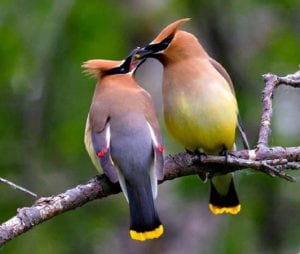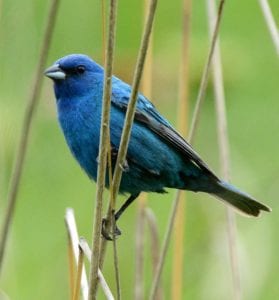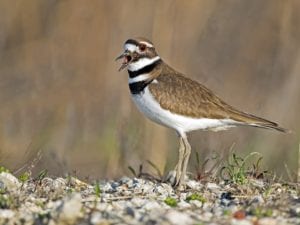Birds and Climate Change
A changing climate affects bird species through a variety of reasons, from earlier spring seasons, to changes in availability of suitable habitat and food supplies. Climate also affects the swing in extreme temperatures and variability of weather. Weather is particularly important for migrating bird species as it can cause delays or detours in routes. Wind speed is an important factor with easier migration when there is a tailwind. Northerly winds (coming from the north) during spring can cause birds to delay flight for days to weeks. The strength of the wind also matters with speeds over 25 mph not favorable to migration. Most likely migration conditions involve moderate tailwinds in non-stormy weather. Stormy weather or heavy precipitation can result in fallouts when many birds have to land suddenly with not a lot of area to choose from.
If you are looking to see migrating birds, the Cornell Lab of Ornithology puts out a forecast in spring and fall, “Birdcast”, to let bird seekers know when weather conditions will favor their favorite species’ migration.
Cedar Waxwing
https://www.audubon.org/field-guide/bird/cedar-waxwing
 The Cedar Waxwing favors areas near fruiting trees and shrubs, making their homes in edge environment (along streams, woods, and yards). Their migration patterns change year to year and their breeding and wintering areas follow food availability. Their population status is stable and they are projected to have a low risk to climate change impacts, including spring heat waves. While they may lose 36% of their range under a 3℃ warming climate scenario, they gain 41% in areas north into Canada during summer. In winter, they are expected to remain stable with only 20% range lost and 49% range gained.
The Cedar Waxwing favors areas near fruiting trees and shrubs, making their homes in edge environment (along streams, woods, and yards). Their migration patterns change year to year and their breeding and wintering areas follow food availability. Their population status is stable and they are projected to have a low risk to climate change impacts, including spring heat waves. While they may lose 36% of their range under a 3℃ warming climate scenario, they gain 41% in areas north into Canada during summer. In winter, they are expected to remain stable with only 20% range lost and 49% range gained.
Indigo Bunting
https://www.audubon.org/field-guide/bird/indigo-bunting?adm1=PA&country=US#bird-climate-vulnerability
 The Indigo Bunting is not a bird species well adapted to urban life, preferring bushy rural areas, old farm fields, and edges of woodlands. They migrate using the stars at night, making their journeys across the Gulf of Mexico in spring and fall. While the species status is currently stable, urbanization and spring heat waves are critical threats to the species, and they are estimated to have a moderate vulnerability to climate change impacts. Under a 3℃ warming scenario, the Indigo Bunting will lose 33% of its range, mostly in the southern U.S. and around the Great Lakes. Their range will be maintained in Pennsylvania and they will gain territory north into Canada, essentially shifting their range north in summer.
The Indigo Bunting is not a bird species well adapted to urban life, preferring bushy rural areas, old farm fields, and edges of woodlands. They migrate using the stars at night, making their journeys across the Gulf of Mexico in spring and fall. While the species status is currently stable, urbanization and spring heat waves are critical threats to the species, and they are estimated to have a moderate vulnerability to climate change impacts. Under a 3℃ warming scenario, the Indigo Bunting will lose 33% of its range, mostly in the southern U.S. and around the Great Lakes. Their range will be maintained in Pennsylvania and they will gain territory north into Canada, essentially shifting their range north in summer.
Killdeer
https://www.audubon.org/field-guide/bird/killdeer?adm1=PA&country=US#bird-climate-vulnerability
 The Killdeer is a common and widespread species that migrates early in spring, returning to northern areas of its habitat range in February and March. It makes its nests around areas near shallow water but also lives in pastures and fields or large lawns. There are population declines localized in urban areas due to habitat loss, as well as detrimental impacts from spring heat waves, but the species is expected to remain stable. Under climate model scenarios, a 3℃ increase due to climate change would result in 7% of its range lost, mostly in southern areas with a gain in range of 32% in northern areas reaching into Canada during summer.
The Killdeer is a common and widespread species that migrates early in spring, returning to northern areas of its habitat range in February and March. It makes its nests around areas near shallow water but also lives in pastures and fields or large lawns. There are population declines localized in urban areas due to habitat loss, as well as detrimental impacts from spring heat waves, but the species is expected to remain stable. Under climate model scenarios, a 3℃ increase due to climate change would result in 7% of its range lost, mostly in southern areas with a gain in range of 32% in northern areas reaching into Canada during summer.
Climate impacts on common bird species in our area (you can filter by most vulnerability to least) https://www.audubon.org/climate/survivalbydegrees/county?zipCode=18042





